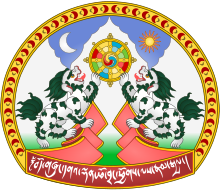Snow lion
| Tibetan name |
|---|
|
Tibetan script :
གཡུ་ རལ་ ལྡན །
སེང་གེ་ དཀར་ མོ ། |
|
Wylie transliteration : g.yu ral ldan,
seng ge dkar mo |
|
Pronunciation in IPA : [
jurɛːtɛ̃],
[seŋke kaːmo ] |
|
Official transcription of the PRCh : Yuraidain,
Sênggê Garmo |
|
THDL transcription : Yurelden,
Senggé Karmo |
| Chinese name |
|
Traditional :
雪山 獅子
|
|
Simplified :
雪山 狮子
|
|
Pinyin : xuěshān shīzi
|
The snow lion (Tib .: gangs seng ge ; after Gendün Chöpel also Gangchen Nag gi Senge , German: lion from the forested Himalayas ) is an allegorical - mythological animal of Buddhism in Tibet . It is the most famous of the symbols of Tibet and can be seen in duplicate on both the flag and the seal of the Tibetan government in exile . It also appears individually on Tibetan postage stamps and coins and mostly in pairs on Tibetan banknotes . In addition to the Garuda , the dragon and the tiger , he is one of the four dignities of the four cardinal points, which can be associated with various aspects of a Bodhisattva and in the middle of which, for example, the wind horse can be depicted on prayer flags . From this point of view , the Garuda symbolizes wisdom , the dragon meek power , the tiger confidence and trust and the snow lion fearless happiness . The snow lion is assigned to the east and according to the Buddhist five-element theory to the element earth.
The roar of the snow lion
In the understanding of Tibetan Buddhism , the roar of the snow lion is equated with the sound of emptiness , courage and truth . That is why it is also seen as a synonym for Buddhist Dharma , which implies the possibility of freedom from karma , represents the teachings of the Buddha and, from a Buddhist point of view, shows the way to enlightenment . The roar of the snow lion is seen in this interpretation as so powerful that only a single roar is capable of dropping seven dragons from the sky.
The milk of the snow lioness

According to a legend of Tibetan folklore , the milk of the snow lioness (Tib .: Gangs Sengemo ) contains certain ingredients that are suitable to heal the human body and restore its harmony. Certain medicines that are considered sacred are said to contain the essence of the snow lion's milk .
The snow lioness' milk symbolizes the purity of Buddhist teaching. Legend has it that a man tried to buy the Dharma with expensive gifts from Milarepa . However, Milarepa refrained from taking the milk of the snow lioness , who lived in snow-covered solitude, and whose milk, like the vital nectar (cf. Amrita ), should be poured into an ordinary vessel in the absence of a golden cup .
Representation in Buddhist art
The body of the snow lion appears white in Buddhist art, whereas the hair on its mane, tail, and curls on its legs can be colored blue or green. Most representations of a snow lion show a gender-neutral snow lion, but there are also snow lions that are clearly male or clearly female. When depicted as a symmetrical female / male pair, the male is on the left and the female is on the right. Snow lion sculptures are often made from chased metal, which is then gilded and colored.
Attributes
Although the snow lion has no wings and therefore cannot actually fly, it is said that its feet never touch the ground. The existence of the snow lions is described as a playful continuum (Tib .: rgyud ) in which they jump from mountain peak to mountain peak. Their Shakti is expressed through the attribute of the Gankyil ( Skt. Ananda - chakra ; Tib. Dga '' khyil ), with which the snow lions play.
In a psychological interpretation, the meaning of the snow lions could best be compared to that of the unicorns or qilins .
The lion dog
Closely related to the Apso Seng Kyi , the Tibetan lion dog Shih Tzu is often associated with the snow lions because of their relative similarities. It is uncertain whether the Shih-Tzu was bred after the image of artistic representations of snow lions or whether artistic representations of snow lions were based on the Shih-Tzu.
See also
Web links
- kalachakranet.org: Tibetan Buddhist Symbols
- www.khandro.net: Lion
- www.geocities.com: The Lion Dog Of Buddhist Asia ( Memento of August 7, 2001 in the Internet Archive )
Individual evidence
- ↑ phayul.com: Gedun Choephel and the Snow Lion By Bhuchte K. Tsering, Tibetan Review, March 2007

